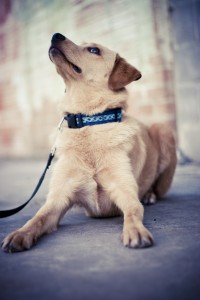
Michael Baugh, CPDT-KA, CDBC
Folks ask all the time, “How often should I train my dog?” I’d like to be able to say every day, all day; your dog is always learning. But people want structure so instead I recommend short sessions (clicker training) several times a day totaling 30 to 40 minutes a day. They are both the right answer. Still, I like the first one better.
Weave training into your everyday life. Make your relationship with your dog a culture of learning. That’s the best way. Now, I’m not really talking about making your dog wait for you to pass through a doorway first. It’s not about requiring him to sit and stay before you put his food bowl down. It’s not even about demanding he sit nicely instead of jumping on your guests. Don’t get me wrong. Those are all very nice manners to teach your dog. But, I’m talking about a different culture of learning, one that has nothing to do with making, requiring or demanding.
It’s about noticing. Here’s a little bit of dog-trainer-geek science. A behavior with a favorable outcome (for the dog) is more likely to be repeated. It’s called Thorndike’s Law of Effect. Scientists don’t hand out that word lightly: Law. Thorndike’s law of effect is just that, a law. It’s been proven, tested and re-tested. That gives you a lot of power when it comes to training. There are lots of favorable outcomes you control: food, playtime, petting, warm smiles and praise. That means you can get a lot of good behavior on the “repeat cycle” of your dog’s repertoire just by leveraging those favorable outcomes. It’s how clicker training works. Your dog does something cool. You click and treat. The dog does that cool thing more.
Okay, what does that have to do with noticing, specifically noticing your dog? Life doesn’t happen in 10 minute clicker training sessions. But our dogs are always learning from us and from the environment. Thorndike’s law of effect is always at play. That means it’s up to us to always be aware of what our dogs are doing, watching for good behavior that we can reinforce (favorable outcome), noticing. That’s the culture of learning I’m talking about. Notice when your dog does something right and be ready to let him know that’s what you like. Now you’re teaching your dog every day, all day.
This may seem difficult, but read on. We humans seem to be pre-programmed to notice when things go wrong not when things go right. While I was writing this my dog, Stella, came over to check in with me. I love that behavior but I ignored it. Later she started barking out the window and she earned my full attention. That’s the way people are, but it’s backwards training. Stella learned that checking in with me got her nothing (no favorable outcome) but barking got my attention (favorable outcome). I ended up on the wrong side of the law, Thorndike’s Law.
Notice. Your dog does great things every day. Never miss a chance to pet him when he sits nicely and gazes at your adoringly. Smile and rub his belly when he curls up at your feet. Throw a party when he comes when called. Then throw the ball and play for a little while. It’s worth it. And it’s a good way to live. Notice what’s right with your dog and be glad. Then notice the people in your life – even the ones you don’t know – and the world around you.
There’s a lot of good going on. Click and treat.

